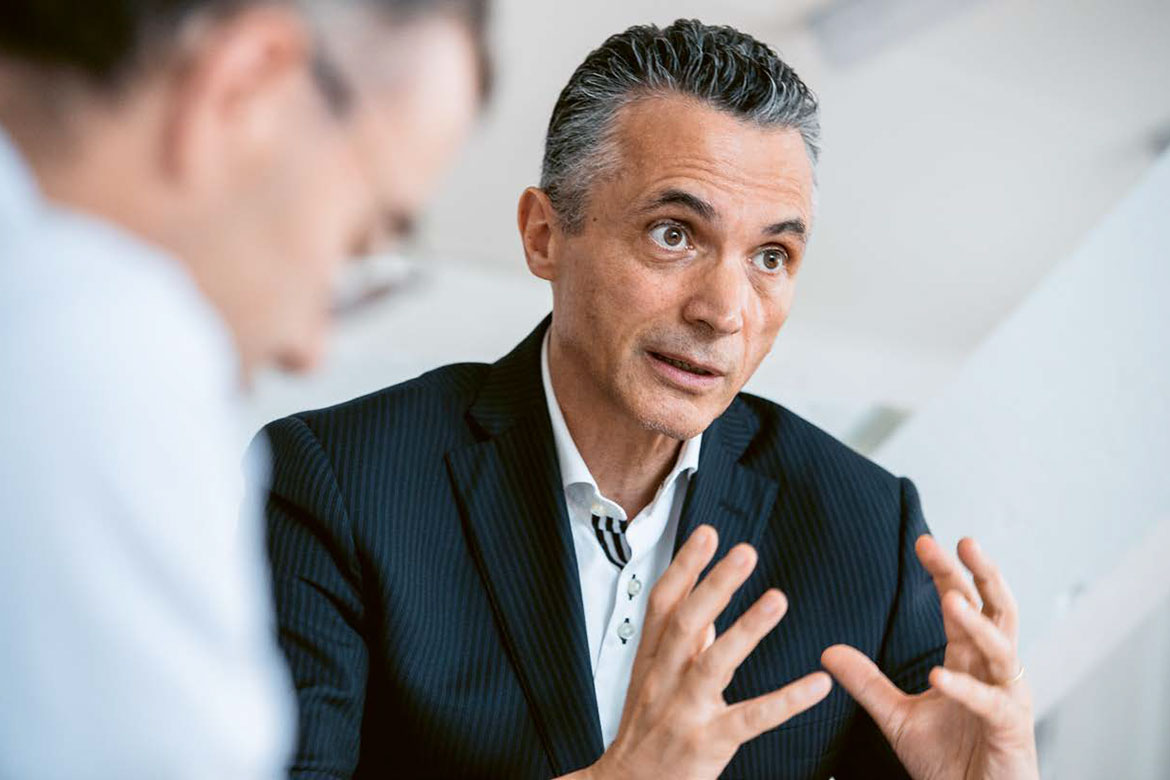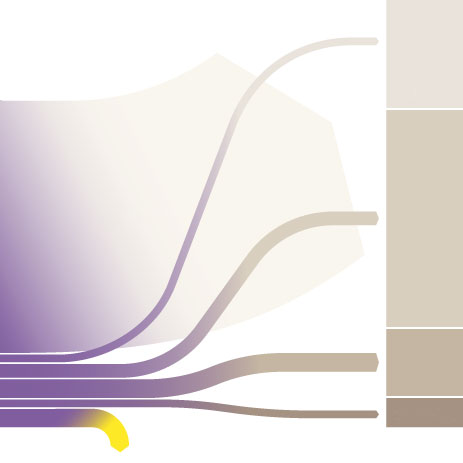Feature: Taking a fresh look at school
Will reforms make all things new?
The Swiss education system works. Is this due to the intense reforms of recent years, or despite them? Some people complain of a mania for reform, while others praise it. We consider the pros and the cons.

Pupils in the seventh grade of Mösli Primary School in Ostermundigen near Bern have been shooting photos for Horizons. | Picture: Nicolas Zonvi
‘Curriculum 21’, ‘HarmoS’, ‘Integrated learning’ – everyone in Switzerland has heard about them, but no one wants them – at least that’s what you might believe if you glance at the media reports about the education reforms of the past 20 years. “Stop this reform mania” was one headline, while other journalists wrote of “suffering teachers” and of a “state of emergency in Swiss schools”. So has this urge to reform the system really ended up as a kind of pathological mania that has only damaged schools instead of improving them?
Urs Moser is a leading empirical researcher into education, and he answers these accusations with more questions: “Who could possibly be against early education? Who could possibly be opposed to educational equity? Or against harmonising the education system among the different cantons?” He does admit that there has been an extraordinary number of reforms since the year 2000. But this is also because the years before had been a time of stalemate, he insists: “It was only in the 1990s that Switzerland dared to take a peek outside its own borders, such as with its participation in international student comparisons such as PISA” (that’s the Programme for International Student Assessment, a worldwide study supervised by the Organisation for Economic Co-operation and Development). He believes that Switzerland simply realised that not everything was proceeding as well as it could.
The educational historian Lucien Criblez is also convinced that reforms are necessary. “If society changes, then education has to adapt”. But he also wants to qualify that: “If the tempo is too fast, however, you are even less able to measure the possible success of reforms than you would be in the first place”.
And indeed it’s very difficult to prove whether reforms have helped pupils to do their sums better, whether they would have got better at them anyway, or whether in fact the reforms have achieved nothing. Moser has conducted many impact studies, and he confirms how difficult it is to reach firm conclusions. Furthermore, every reform brings its own problems and side-effects and prompts new criticism. In this, both Moser and Criblez agree. “In the short term, these side-effects are always regarded as really bad – but in the long term, people realise that a lot of things have actually stayed the same”, says Moser. His bottom line is this: “Our education system, which is subject to increasing demands, hasn’t got any worse on account of the reforms that have been implemented. The overall impact has instead been for the good”.
1970s: Comprehensive schools
Why did it come about?
In the wake of the 1968 revolts, with their institutional criticism and their debates about anti-authoritarian education, state schools came more and more under fire. The practice of selection was criticised, for example. “Equality of opportunity was a big topic”, says the education historian Lucien Criblez. One solution to this seemed to lie in the organisational form of schools, and comprehensive education was intended to allow strong and weak pupils to learn next to each other and from each other.
The result
In Switzerland from the 1990s onwards, the emphasis was on cooperative models in which pupils were assigned to a class streamed according to their level of achievement. But for specific subjects, they were put in classes catering for different ability levels. The goal was to increase the through-put among the different types of secondary school. To this day, it is left to individual cantons to decide whether or not they want to introduce integrated comprehensive schools, and, if so, how they want to do it. Educators have vastly different opinions on the effectiveness of such schools. Some insist that they offer necessary support to weaker pupils, while others believe that the weaker pupils hold back the cleverer children. The education researcher Urs Moser says: “The structural reforms were only of limited impact, because academic achievement is largely independent of the idiosyncrasies of school structures”. But it cannot be claimed that comprehensive schools were a failure. “In general, establishing a greater through-put between different achievement levels helps to break down social inequalities”.
1990s: Vocational baccalaureate
Why did it come about?
From the 1950s onwards, businesses found it more and more difficult to satisfy their increasing need for well-trained engineers. Good school students preferred to go to grammar schools instead of doing apprenticeships. In the 1970s, the technical colleges began to complain of dwindling numbers, and the traditional universities began to consider restricting entry. The competition between these two types of institution led to the idea of the vocational baccalaureate, which was anchored in the statute books in the 1990s.
The result
The public reputation of vocational education was strengthened by the introduction of the vocational baccalaureate. It made vocational training more attractive to gifted school students, and encouraged businesses to offer apprenticeships. Within a few years, there was an extensive range of apprenticeships on offer. The introduction of the vocational baccalaureate and of universities of applied sciences meant a clear upgrade for vocational education. “The number of people with a tertiary education has increased in recent years”, says the education researcher Urs Moser.
1990s: The move to tertiary teacher education
Why did it come about?
“After the Second World War, there was a period when schools suffered from a great lack of personnel, and this trend reached a peak in the 1960s. A whole series of measures was adopted with the aim of training more teachers”, says the education historian Lucien Criblez. Since then, there have been innumerable concepts, outlines and recommendations regarding teacher training. People believed that this demanding profession required an especially well-founded, attractive training programme. But it was only in the early 1990s, at a time of increasing mobility within Switzerland and increasing integration in Europe, that there was sufficient pressure for change to happen. Criblez adds: “Switzerland also wanted to prevent Swiss teaching qualifications from being discriminated against abroad”.
The result
Until the 1990s, teacher training primarily meant attending teacher training colleges, the ‘Lehrerseminare’. “What was new was the move away from these colleges to tertiary-level, academically founded training”, says the education researcher Urs Moser. “Critics back then focussed on a lack of practical orientation. But that was wrong. The practical part of the training offered by the universities of education has not been reduced”. There were also discussions about whether or not kindergarten teachers need tertiary education. According to Criblez, “some people regarded the existing, more manageable institutions as better than the big tertiary institutions. And they wanted to keep aspects of personality development restricted to an age when students were more malleable”. But the reforms were made, and they were successful too, says Moser.
2007: Special education
Why did it come about?
“Already in the 1990s, it was pretty clear that children with learning difficulties were supported better in regular classes than in special classes. Putting them with the other children also gave them better chances for integration in the labour market”, says the education researcher Urs Moser. An integrative approach to special needs education was also a logical consequence of the reorganisation of the schools that had already taken place. It meant that schools took on more responsibility and had to adapt more to the needs of the children.
The result
Wild children, calm children, children with special needs: they’re all taught in the same class today, since the reduced-size classes and special-needs classes were abolished. “In recent years there was only really one reform that was particularly daring and that demanded a rethink in schools: inclusion. Getting rid of special-needs classes and requiring more integration from schools was a decisive step”, says Moser. There was a correspondingly great degree of scepticism towards the integrative school model. Some educators prophesied it would mean so much extra work that the schools would be unable to cope – and in this they had the support of the Public Sector Service Union (VPoD). It was inevitable – so it was claimed – that so-called ‘normal’ children would produce worse results. At present, it is still difficult to tell whether that has turned out to be the case. But the public debate about it has mostly ceased.
2009: HarmoS
Why did it come about?
“In recent decades, people in Switzerland have become ever more mobile. This brought with it a need to harmonise our schools across the country. Children and teachers have to be able to move smoothly from one school to another. So the decentralised organisation of our education couldn’t be allowed to hinder them any more”, says the education historian Lucien Criblez. The referendum about it on 21 May 2006 also saw an overwhelming majority of Swiss citizens in favour – 85.6 percent.
The result
The ‘Intercantonal agreement on the harmonisation of compulsory education’, ‘HarmoS’ for short, compelled the cantons to agree unified rules on the most fundamental aspects of education, from the school entrance age to the length of basic education, the most important goals and the transitions between individual school levels across all of Switzerland. The ‘Curriculum 21’ was one of the measures introduced by HarmoS.
Despite the unequivocal result of the referendum, the plans for harmonising Swiss schools aroused such anxieties that the process did not run harmoniously. People complained that it meant cutbacks to education, and they criticised bureaucrats for encroaching on the education system. The cantons felt threatened in their autonomy, and some people even claimed that making kindergarten obligatory would rob children of their childhood, while the introduction of two foreign languages at primary school would overwhelm them.
“There were indeed contradictory scientific studies about the value of teaching two foreign languages at primary school level”, says the education researcher Urs Moser. “But it is relatively uncontested that while learning foreign languages is easier for older children, the children learn more overall if they start learning earlier”.
Today, people seem to have stopped worrying. The Conference of Cantonal Directors of Education (EDK) wrote in its report for 2015: “What has been achieved in the space of just six years is considerable”. It is clear that compulsory school education in Switzerland has never been as broadly harmonised as it is today. The goal of making a smooth transition possible from one school to another has been attained. “Nevertheless, the immense energies expended to implement the reform are a negative side-effect”, says Criblez.
2015: Curriculum 21
Why did it come about?
Curriculum 21 (‘Lehrplan 21’) is an instrument for harmonising elementary school (see HarmoS). Twenty-one German-speaking and multilingual cantons decided to implement a joint revision of their curricula. Curriculum 21 is intended to ensure that all the cantons have comparable goals in all subject areas. At the same time, the cantons have the opportunity to adjust the curriculum to meet their own needs.
The result
The draft document has been ready to go to press since late March 2015. Above all, it stipulates basic skills that schoolchildren should learn. But there has been a lot of criticism: it requires children to attain too many competences, say some, while specifying too little content. “Above and beyond this, a lot was bound up with Curriculum 21 that was not originally intended. Such as the exclusively self-regulated learning and the constant measurements of what was taught”, says the education researcher Urs Moser. What is clear is that this curriculum contains much that was already present in the earlier curricula, because the latter were an important source for those drawing up the new document. Many of the current teaching materials can continue to be used, and there is no impact on the methodological freedom afforded to teachers.
The future: Digitalisation
Why will it come about?
Learning with YouTube, or schools without math because machines do it better – it’s difficult to predict how digitalisation will change our education system. Lucien Criblez is convinced that “the technology debate is the big topic of the next ten years. But it would be naïve to believe that you can change education through teaching media”. Klaus Rummler, an educational scientist and sociologist at the Zurich University of Teacher Education (PHZH), also says that “access to the Internet across school campuses is primarily an innovation in infrastructure”.
The result
So does this mean there will be some new possibilities, but otherwise old wine in new bottles? To be sure, the curriculum ought to be better adapted to prepare pupils for the digitalisation of society. The media scientist Sarah Genner has written in the Neue Zürcher Zeitung that digital competences have to be communicated – such as how to deal critically with digital sources, social competence in online communication, knowledge about secure passwords, the digital private sphere and the ability to shield oneself from permanent digital distractions. But she is also confident that Switzerland’s dual education system gives it an immense advantage in comparison to almost every country in our age of technological change. “The most up-to-date, professional, trade-specific technologies can be learnt on the job”. Already today, major upgrades are taking place. Curriculum 21, for example, has introduced the subject ‘media and IT’. And in the national research programme ‘Digital transformation’, education is a major focus area.




